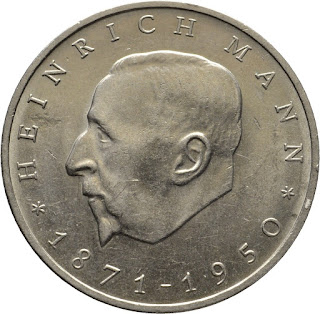German Coins GDR 20 Mark 1971 Heinrich Mann
Commemorative issue: 100th Anniversary - Birth of Heinrich Mann
Obverse: The National Emblem of the German Democratic Republic (a hammer and a compass, surrounded by a ring of rye) and the face value of 20 Mark.
Lettering: DEUTSCHE DEMOKRATISCHE REPUBLIK 1971 20 MARK.
Reverse: Bust of Heinrich Mann.
Lettering: HEINRICH MANN * 1871-1950 *
Edge: Smooth with inscription.
Lettering: 20 MARK * 20 MARK * 20 MARK * 20 MARK *
Year: 1971.
Value: 20 Mark (20 DDM).
Metal: Copper-nickel.
Weight: 16.5 g.
Diameter: 33 mm.
Shape: Round.
Heinrich Mann
Luiz (Ludwig) Heinrich Mann (27 March 1871 – 11 March 1950) was a German novelist who wrote works with strong social themes. His numerous criticisms of the growth of fascism forced him to flee for his life after the Nazis came to power in 1933.
Born in Lübeck, as the oldest child of Thomas Johann Heinrich Mann and Júlia da Silva Bruhns, he was the elder brother of novelist Thomas Mann. His father came from a affluent family of grain merchants and was a Senator of the Hanseatic city. After the death of his father, his mother moved the family to Munich, where Heinrich began his career as a freier Schriftsteller or free novelist.
Mann's essay on Zola and the novel Der Untertan earned him much respect during the Weimar Republic, since it satirized German society and explained how its political system had led to the First World War. Eventually, his book Professor Unrat was freely adapted into the legendary movie Der Blaue Engel (The Blue Angel). Carl Zuckmayer wrote the script, and Josef von Sternberg was the director. The book's author wanted his girlfriend, the actress Trude Hesterberg, to play the lead, but instead Marlene Dietrich was given her first sound role as the "actress" Lola Lola (named Rosa Fröhlich in the novel).
Together with Albert Einstein and other celebrities, Mann was a signatory to a letter to the Urgent Call for Unity condemning the murder of Croatian scholar Dr Milan Šufflay on 18 February 1931.
Mann became persona non grata in Nazi Germany and left even before the Reichstag fire in 1933. He went to France where he lived in Paris and Nice. During the German occupation he made his way through collaborationist Vichy France to Marseille where he was aided by Varian Fry in 1940 to escape to Spain. He eventually escaped to Portugal and then to America.
The Nazis burnt Heinrich Mann's books as "contrary to the German spirit" during the infamous book burning of May 10, 1933, which was instigated by the then Nazi propaganda minister Joseph Goebbels.
During the 1930s and later in American exile, Mann's literary popularity went downhill. Nevertheless, he wrote Die Jugend des Königs Henri Quatre and Die Vollendung des Königs Henri Quatre as part of the Exilliteratur. The two novels sketched the life and importance of Henry IV of France and were acclaimed by his brother Thomas Mann, who spoke of the "great splendour and dynamic art" of the work. The plot, based on Europe's early modern history from a French perspective, anticipated the end of French–German enmity.
Heinrich Mann died in Santa Monica, California, lonely and without much money, just months before he was to move to East Berlin to become president of the German Academy of Arts. His ashes were later taken to East Germany.
His second wife Nelly Mann (1898–1944) committed suicide in Los Angeles.

